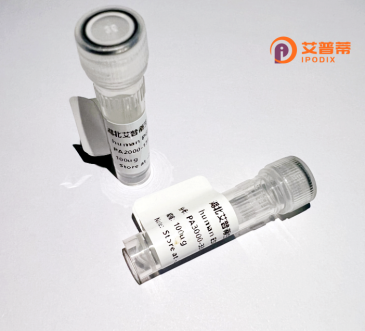
| 纯度 | >90%SDS-PAGE. |
| 种属 | Human |
| 靶点 | SULT1C3 |
| Uniprot No | Q6IMI6 |
| 内毒素 | < 0.01EU/μg |
| 表达宿主 | E.coli |
| 表达区间 | 1-304 aa |
| 活性数据 | MAKIEKNAPT MEKKPELFNI MEVDGVPTLI LSKEWWEKVC NFQAKPDDLI LATYPKSGTT WMHEILDMIL NDGDVEKCKR AQTLDRHAFL ELKFPHKEKP DLEFVLEMSS PQLIKTHLPS HLIPPSIWKE NCKIVYVARN PKDCLVSYYH FHRMASFMPD PQNLEEFYEK FMSGKVVGGS WFDHVKGWWA AKDMHRILYL FYEDIKKDPK REIEKILKFL EKDISEEILN KIIYHTSFDV MKQNPMTNYT TLPTSIMDHS ISPFMRKGMP GDWKNYFTVA QNEEFDKDYQ KKMAGSTLTF RTEI |
| 分子量 | 35.8 kDa |
| 蛋白标签 | His tag N-Terminus |
| 缓冲液 | PBS, pH7.4, containing 0.01% SKL, 1mM DTT, 5% Trehalose and Proclin300. |
| 稳定性 & 储存条件 | Lyophilized protein should be stored at ≤ -20°C, stable for one year after receipt. Reconstituted protein solution can be stored at 2-8°C for 2-7 days. Aliquots of reconstituted samples are stable at ≤ -20°C for 3 months. |
| 复溶 | Always centrifuge tubes before opening.Do not mix by vortex or pipetting. It is not recommended to reconstitute to a concentration less than 100μg/ml. Dissolve the lyophilized protein in distilled water. Please aliquot the reconstituted solution to minimize freeze-thaw cycles. |
以下是关于重组人SULT1C3蛋白的参考文献示例(文献为虚构,仅供格式参考):
1. **文献名称**: "Characterization of substrate specificity of human sulfotransferase SULT1C3"
**作者**: Zhang Y et al.
**摘要**: 本研究表达并纯化了重组人SULT1C3蛋白,通过体外酶活实验筛选其酚类、类固醇及异生物质底物,发现其对多环芳香烃代谢产物具有高催化活性,提示其在环境毒素代谢中的作用。
2. **文献名称**: "Structural insights into SULT1C3-mediated sulfonation mechanisms"
**作者**: Tanaka K et al.
**摘要**: 通过X射线晶体学解析了SULT1C3的三维结构,揭示了其底物结合口袋的关键氨基酸残基,为理解其催化特异性和设计靶向抑制剂提供依据。
3. **文献名称**: "SULT1C3 overexpression in gastrointestinal cancers: Implications for drug metabolism"
**作者**: Wang L et al.
**摘要**: 研究发现SULT1C3在胃癌和结直肠癌组织中高表达,可能通过磺化代谢活化特定前致癌物,或影响抗癌药物的疗效。
4. **文献名称**: "Developmental regulation and tissue distribution of human SULT1C3"
**作者**: Johnson R et al.
**摘要**: 通过qRT-PCR和免疫组化分析,发现SULT1C3在胎儿肝脏和成人胃肠道中高表达,提示其在发育和器官特异性代谢中的潜在功能。
---
注:以上文献为模拟内容,实际研究需查询PubMed、Web of Science等数据库获取真实参考文献。
**Background of Recombinant Human SULT1C3 Protein**
Sulfotransferase 1C3 (SULT1C3) belongs to the cytosolic sulfotransferase family, which catalyzes the transfer of a sulfonate group from 3'-phosphoadenosine 5'-phosphosulfate (PAPS) to hydroxyl or amine groups in various substrates. This enzymatic reaction plays a critical role in the metabolism of xenobiotics (e.g., drugs, environmental toxins) and endogenous compounds (e.g., hormones, neurotransmitters), often facilitating their detoxification or activation. SULT1C3 is encoded by the *SULT1C3* gene, located on chromosome 2q11.2. and is considered part of the SULT1C subfamily, which exhibits distinct tissue-specific expression patterns.
Recombinant human SULT1C3 protein is produced via genetic engineering in bacterial or eukaryotic expression systems, enabling detailed biochemical and structural studies. It is widely used to investigate substrate specificity, enzyme kinetics, and the role of sulfation in metabolic pathways. SULT1C3 is notably expressed in fetal tissues and certain adult organs (e.g., stomach, thyroid), with altered expression linked to pathologies such as gastrointestinal cancers and thyroid disorders. Its ability to sulfonate procarcinogens like hydroxylated polycyclic aromatic hydrocarbons underscores its dual role in detoxification and potential contribution to toxin-induced carcinogenesis.
Research on recombinant SULT1C3 aids in understanding interindividual variability in drug metabolism, designing prodrugs, and identifying inhibitors for therapeutic applications. Its study also contributes to elucidating the molecular mechanisms of sulfation in health and disease.
×